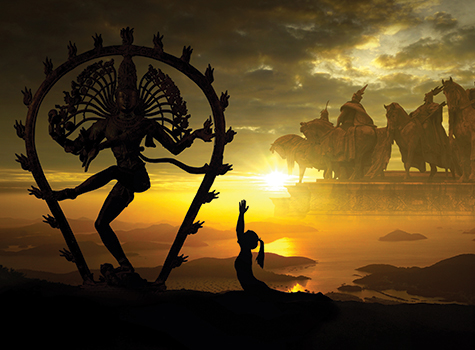By Preethi Sriram

The pandemic time has made me an introspective person. Or maybe I have always been introspective, and pandemic just increased that ability.
In this time, I contemplate further why I learn to dance, especially within the Indian Classical arts form.
I am older and so no one urges me to learn Indian Classical Dance or the Indian Arts. Sometimes in classes I have been in, people will ask the “youngsters” why they take class. If I was asked as a kid, I would have been unsavvy and answered that “My friends are here.” “We get to hang out after.” Or maybe “There is a soda machine in the break room area” and I want to have a nice cola drink after class. My most unsavvy answer that I probably would have not answered in such a realistic way but would have been thinking as my friends and I would maybe snicker if I were gutsy enough to have said so is “because I have no choice.” But kids these days, they are savvier. Probably more self-actualized than I ever could have been at their age.
I could have stopped as a teenager after high school when I had the chance. No one would have stopped me, or to become philosophical, I would have had no other motivation factors to push me to attend any dance classes. Moving to another state and school would have been a great way to end the journey.
Job wise, at this time, I probably do not need to have it added to my resume. That went with the wayside after high school and college. These days, kids can add it to their resumes (they probably did back in the day, but prior to social media and mass sharing of information, it was not known at least to me). I don’t think I ever actually had it added as an extracurricular activity to my resume even in school.
Today, maybe I could add it to my resume, but being honest, no one really would care (and realistically, for resume purposes in the job market, it would not be beneficial to add it, unless it was a role that I was specifically applying related to dance or something within the given field that would benefit the position directly) or may generate a slight pique of interest and seen as a nice hobby. Maybe it would be seen as a nice workout. A great form of exercise.
But that brings me to the present of why dance? If I wanted to exercise, technically, I don’t necessarily need Bharatanatyam or any other Indian Classical Dance form for that matter to do so. It is just not efficient in comparison to the market availability of many other products available. I could turn on any numerous exercise videos from a list of selections (which I do, maybe once in a blue moon).
So, what about Yoga? With me being too nervous to go to the gym during pandemic time, I have tried to learn to stretch out on my own. I have tried to meditate. Maybe I am currently not at the stage of an expert of that, but yoga and meditation are not easy. They are within themselves a practice that takes much time and dedication and sitting quietly is harder than it looks.
What drives me then to dance, if I can barely turn on an exercise video or find it difficult to stretch religiously and sit quietly?
Is it because I am trying to be “cool?”
The Richter scale for cool for dance is not available for Indian Classical Dance at the moment. Since I will say that I am already cool, it is not necessary for me to add Indian Classical Dance to be any cooler. I am beyond the societal constructs anyway of what it means to be cool.
So out of everything, the instinctual question is why do I want to learn dance? What is my motivation?
Being an adult, most of these questions come from oneself. Again, no one asks you why you do what you do. And if they do, the superficial answers may come about. So, it is important to explore who am I. But I am not just me but am a product of many generations before myself. To know myself, I need to know history.
An aspect of my learning in Indian classical dance involves trying to understand the history of the dance form itself and to truly understand the dance. I want to understand the dance form and structure of the people who came before me to have a deeper understanding of the art itself.
One of the aspects I really want to understand as an older, and more mature student of dance, is the concept of the devadasi. This is a concept that many students of the Indian Classical Arts may be aware of, or may have heard the terms, but there is a treasure trove of philosophy regarding this prior artist group.
In the book Women of Pride: The Devadasi Heritage by Lakshmi Vishwanathan, the author delves into the lives of the Devadasi and the dance form of classical Indian dance from a historical view. This book is a fascinating read of the historical aspects of the Devadasi for those who are interested.
For me, the dance is a form of communication.
Who am I communicating with though and what sources are used and cited when communicating information?
For Indian classical dance, one cannot just robotically dance the moves. Sure, it is possible, but there needs to be an understanding of the philosophies of Indian culture and thoughts and the history of the dance itself. To express the sentiment of the dance, there is more to it than just a simple technical execution of the dance. Dancers can be amazing technically, but if they cannot express or convey the ideas of the dance or make the audience feel beyond the physical aspect of the dance, then they have only given a surface view of what the dance is meant for. The artist must know the “why” of their art and the why of the art form itself.
As an adult, when I am learning a dance piece, to fully understand how to convey the emotions of the dance, I need to know the meanings of the song- if it is in a language I do not know, what are the lyrics? Who wrote the song? What is the emotion of the song? If the song is about Krishna, who is Krishna? What texts have Krishna noted in it? Is it the Mahabharatham?
Not only do I learn about Krishna, one of the Hindu incarnations of Lord Vishnu, through reading a book, I need to understand who Krishna is. How does he look? Neela Megha Shyamalan. What does that mean? How to convey that phrase?
I not only read and delight of the various tricks of the child Krishna when reading, I enact the role of Krishna: stealing the butter from the Gopis. I enact when Krishna puts mud in his mouth and gets chastised by his mother. I become the adorer of Krishna, who is Yashoda who sees the universe within the mouth of Krishna. I am Arjuna, the friend of Krishna, the Gopis who swoon, and even the deer who forgets oneself when listening to Krishna’s flute.
When dancing these pieces, I am communicating this story not only to the direct audience in front of me (if there is an audience), but I feel I am also connecting with my ancestors if they by chance are watching me. I am telling them about Krishna as a mischievous child. Or Krishna charming the Gopis.
Maybe they will be soothed and calmed from any difficulties they may have. Maybe they will tell me my technique is off. Maybe a better dancer somewhere in the line of my ancestors (or a great critic) will say to sit more in my adavu form and keep my back straight. Maybe they will tell me to stick to my day job.
But I still feel I am connecting, and I feel connected to those before me and those who may come. I am telling them their story. Our story. The story of humanity through story telling. While I can be a very direct person, the art form is subtle and intricate. The stories that are used for the dance have messages that can reach different people in different ways. It can go from superficial to deep depending on who receives the message and what they are ready to learn. It does not force any one specific message but allows the receiver to learn at their time. This is a lesson for me. It teaches me how to be subtle in my communication when it is needed and to understand the audience and what they can enjoy.
Going back to my attempts of yoga and meditation, the physical aspect of the dance is the physical yoga of the body. The meditation comes in as one is dancing on the different divinities.
As a student of Classical Indian Dance, I am learning the concepts of yoga and meditation through the art form. We all have different abilities and suited differently per our bodies and mental capacities, and I am more suited for this form of yoga and meditation currently.
The dance as an entirety is a form of worship.
The why of dance and the drive of dance comes now to a full circle.
It is a form of exercise in its most simple form, a medium for learning the history and philosophies of India from a kinesthetic manner, a channel for communicating and soothing the spirts still here, a type of yoga and meditation, a spiritual service to society for lessons in dharma, and a way to worship the divinities.
The Classical Indian Arts is an all-inclusive package.
Preethi Sriram is a classical Indian dance enthusiast and lifelong learner of dance.
Contact: [email protected]



